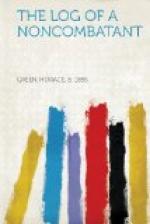Military men, English as well as German, to whom I have talked, take it as a matter of course that the highest spot in any locality is used for observation. As an English officer in Antwerp put it, “If the French did not use the church tower they are d------fools.”
By way of guide and for sake of likely comparison I can state what I know did happen in two other cities: Termonde and Antwerp. In Chapter II of this book I have told how we made our way across the broken bridge at Termonde on the day of its second bombardment, and how that night word came to us of the manner in which the Belgians took revenge on the conquerors. I told how staff officers, entering with a scouting party at the head of a German column, mounted the only remaining spire in the town. With a few well-directed shots from their concealed batteries west of the river, the Belgians destroyed the tower and killed the officers. The Belgians took no little pride in their marksmanship on that occasion, and boasted freely of it. In this case, the use, and therefore the destruction, of the observation-post was looked upon by the Belgians as a natural and necessary instance of the work of war. As evidence, it is rather valuable because given unconsciously and without motive.
Likewise at Antwerp. In all probability the fact has never been appreciated that during the bombardment of this city,—the most important, from a military point of view, in Belgium,—the spire of the Notre Dame Cathedral was used as an outlook-station by the Belgian defenders, if not by both Belgians and English. On the inadvertent testimony of English themselves I know this to be true. On the second night of the Antwerp bombardment the Americans who had not left the city were gathered in the almost deserted Queen’s Hotel along the water front. Some time during the evening, I don’t remember just when, but it was while the British retreat was going on, an English lad called Lucien Arthur Jones burst in upon us. At no little risk he had dodged through the deserted streets and falling shells, much elated over the view of the enemy he had just got from the cathedral tower.
“I’ve had bully luck,” he confided to me, after I had done him a noble service (i.e., lent him a safety razor). “Belgian signal officers took me up to the tower, where they can see everything the Germans are doing.”
The following is taken from his account—an Englishman’s account— printed in the London Chronicle, and copied in the New York Times, Tribune, and other papers:—
“I now return to the events of Thursday. At 12.30 o’clock in the afternoon, when the bombardment had already lasted over twelve hours, through the courtesy of a Belgian officer, I was able to ascend to the roof of the cathedral, and from that point of vantage I looked down upon the scene in the city. I could just discern through my glasses dimly in the distance the instruments of culture of the attacking German forces ruthlessly pounding at the city and creeping nearer to it in the dark. At that moment I should say the enemy’s front line was within four miles of Antwerp.




